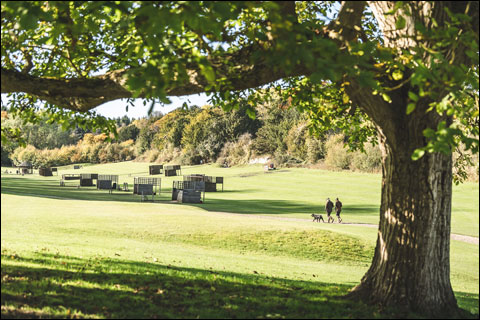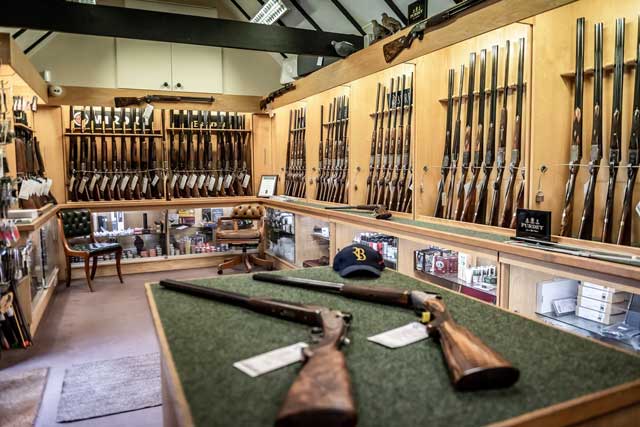The Wingshooting Schools of England: Part 1, James Purdey & Sons’ Royal Berkshire Shooting School

I’m standing in a waist-high grouse butt at the Royal Berkshire Shooting School in rural Pangbourne, England. Jonathan Irby, the school’s Managing Director, really wants me to make this shot: an incoming formation of four clay targets strafing the scrub at about 50 miles per hour. In a way, this shot is a test to see if I have the stuff for hunting the 20-ounce, acrobatic, mind-bending red grouse that can burst to speeds of nearly 80 miles per hour – exasperating wingshooters throughout the U.K. for the past 150 years.
In late November 2019, when upland fever runs high, Shotgun Life opted for a contrarian trip to the outskirts of London for stops at arguably the best clays grounds in the world. Our experience was a revelation. While American sporting clays has gradually deviated from its origins as off-season wingshooting practice, England’s shooting grounds remain devoutly steadfast in providing simulated wingshooting and instructions for estate and moorlands shoots of pheasants, partridge and red grouse. Despite the proximity to London, the shooting grounds are surprisingly pastoral, sprawling and, of course, suffused with British tradition. We visited James Purdey & Sons’ Royal Berkshire Shooting School, West London Shooting School, E.J. Churchill Shooting Grounds, Holland & Holland Shooting Grounds and Atkin Grant & Lang. Join us…
Written by Irwin Greenstein
The Wingshooting Schools of England: Part 1, James Purdey & Sons’ Royal Berkshire Shooting School
I’m standing in a waist-high grouse butt at the Royal Berkshire Shooting School in rural Pangbourne, England. Jonathan Irby, the school’s Managing Director, really wants me to make this shot: an incoming formation of four clay targets strafing the scrub at about 50 miles per hour. In a way, this shot is a test to see if I have the stuff for hunting the 20-ounce, acrobatic, mind-bending red grouse that can burst to speeds of nearly 80 miles per hour – exasperating wingshooters throughout the U.K. for the past 150 years.
The bird commands so much respect that August 12th, the opening day in England, is known as the Glorious Twelfth, and naturally starts with the big-money shoots of driven red grouse.
 The author (left) with Jonathan Irby at the Royal Berkshire Shooting School. This particular grouse butt threw a 20-bird sequence – ending in a presentation of four simultaneous, high-velocity, extremely low incoming targets.
The author (left) with Jonathan Irby at the Royal Berkshire Shooting School. This particular grouse butt threw a 20-bird sequence – ending in a presentation of four simultaneous, high-velocity, extremely low incoming targets.In the grouse butt, Mr. Irby points downfield to the distant tree line where a trapper, hidden in the woods manning hand traps, will unleash the birds. For this particular position, he talks about focus, gun hold, swing – bringing to bear the expertise from his career over a decade ago as General Manager of the fabled West London Shooting School. At this point in the day, having shot several simulated wingshooting stations as well as other targets from this position, I had gained confidence in the 12-gauge Purdey Sporter over/under bearing 30-inch barrels. I nod, then Mr. Irby pushes the talk button on the walkie-talkie.
At first sight of the formation, about 60 yards out, your mind plays tricks, duping you into thinking “I have plenty of time.” But as the targets blaze toward the right side of the butt, curling and dropping further to the right, there’s the horrible realization that suddenly it’s too late. I shoulder the Purdey and swing around hard to smash one that’s already behind me.
Yes, I did it, and Mr. Irby anoints me a hunter of red grouse.
 Jonathan Irby in the farm house.
Jonathan Irby in the farm house.It felt like I got a taste of the school’s spirited competition called the Species Challenge, which usually starts in late January. You’ll experience five game flushes of Novar Walked Up, Stanage High Pheasant, Bransdale Driven Grouse, Purdey Scottish Grouse and Las Barracas Spanish Partridge.
The Species Challenge demonstrates the philosophical difference from sporting clays, which has evolved into a game of target setter versus shooter. By contrast, there’s a highly practical element to the Royal Berkshire Shooting School, and it has to do with wingshooting in the U.K.
If you’re paying between $1,300 to $4,000 per day to hunt birds on an estate or in the moors, and let’s stay about 500 birds will be released for a shooting party of eight, you certainly don’t want to miss that very expensive, high driven pheasant or sprightly red grouse. So to assuage your ego and wallet, if you advise the Royal Berkshire Shooting School in advance where you expect to be hunting, the staff will customize a simulated shoot to mimic your quarry as closely as possible.
 Several of the simulated wingshooting stands at the Royal Berkshire Shooting School.
Several of the simulated wingshooting stands at the Royal Berkshire Shooting School.“We have an infinite number of shooting positions,” Mr. Irby said of the 65-acre grounds encompassing more than 50 automatic traps, about 180 manual traps and some 40 stands.
“We have a large number of manual traps,” he said. “We believe that you get a better presentation and can incrementally change its position and speed to help students. We can put a manual trap on a shoulder and carry it into places inaccessible for an automatic trap machine. It’s a more interactive process.”
The emphasis of wingshooting versus sporting clays makes the Royal Berkshire Shooting School more about table fare than a score-sheet X. You’re taking lessons, not necessarily to outshoot the pack, but to engage a challenging game bird. Instead of a trophy, your intended prize is a convivial supper.
 Shotgun Life Editor Deborah McKown in a grouse butt with Jonathan Irby.
Shotgun Life Editor Deborah McKown in a grouse butt with Jonathan Irby.Purdey acquired the Royal Berkshire Shooting School in April 2018. “The shooting school was a missing piece at Purdey,” explained Mr. Irby. “We love the fact that we now have our own shooting school. I want it to be the best shooting school in the country.”
Purdey has no intention of changing the school’s name or even the original prices. “We bought Royal Berkshire for the name and the brand,” Mr. Irby continued. “We’re looking for new faces, recommended by old faces.”
 The original stone farmhouse on the grounds of the Royal Berkshire Shooting School.
The original stone farmhouse on the grounds of the Royal Berkshire Shooting School.When word spread about the Purdey acquisition, local farmers who need ammunition and gear were concerned the inventory would become exclusively up-market. But as Mr. Irby asserted, there will be minimal changes to the culture of the Royal Berkshire Shooting School. The gun room still stocks shotguns and rifles from Perazzi, Blaser, AyA, Browning, Holland & Holland, Piotti, Beretta, Boss, Miroku and Caesar Guerini.
“We will always sell you the right gun,” Mr. Irby said. “We won’t upsell you.”
And by the right gun, he also meant that the school provides gun-fitting services.
 The gun room at the Royal Berkshire Shooting School.
The gun room at the Royal Berkshire Shooting School.The Royal Berkshire Shooting School dates back to 1991, when it was started by Dylan Williams on an old farm. (The original stone farm house circa early 1700s remains in use with plans for additional modernization.) By 2010, the school had been sold to Alexander Newman, who is a London-based Investment Banker. Mr. Williams, meanwhile, remains the school’s Managing Director under Purdey’s ownership.
Under Purdey, the Royal Berkshire Shooting School will retain its Caliber Club, which includes membership benefits of club socials, cigars and wine tastings, special member prices for lessons, and discounts at the Gun Room, Country Store and Wild Fork Café. There’s also the Royal Berkshire Sporting Agency that arranges shooting in the U.K., Spain, Africa and Argentina.
 The store at the Royal Berkshire Shooting School provides essentials and accessories to visitors and locals.
The store at the Royal Berkshire Shooting School provides essentials and accessories to visitors and locals.Recently the Caliber Club started offering shared membership at Griffin & Howe’s Hudson Farm shooting grounds in Andover, New Jersey, stemming from Hudson Farm’s appointment as Purdey’s American Northeast base of operations in October 2017.
“In concert with the deepening relationship between Griffin & Howe at Hudson Farm and James Purdey & Sons, both parties have opted to offer reciprocal memberships of their shooting facilities,” explained Guy Bignell, former president of Griffin & Howe and their Purdey gun sales specialist. “Royal Berkshire members get use of Hudson Farm facilities and Hudson Farm members become members of Caliber Club. This cements the relationship between Purdey and Griffin & Howe.”
 Jonathan Irby and Griffin & Howe’s Guy Bignell catching up in the farm house at the Royal Berkshire Shooting School.
Jonathan Irby and Griffin & Howe’s Guy Bignell catching up in the farm house at the Royal Berkshire Shooting School.(As it turned out, we ran into Mr. Bignell at the Royal Berkshire Shooting School. He joined in the shooting and later for an excellent lunch at the historic Royal Oak Inn in Yattendon, the school’s preferred lodging.)
Given Purdey’s reputation as a premium British institution, you’ll find the Royal Berkshire Shooting School unceremoniously comfortable. Whereas Purdey’s Audley House in London is a showcase of proper British shooting with a contemporary flair, the Royal Berkshire Shooting School is an invitation to a more casual side of Purdey that makes the brand more approachable – and lots of fun as well.
Irwin Greenstein is the Publisher of Shotgun Life. You can reach him at contact@shotgunlife.com.
Helpful resources:
The Royal Berkshire Shooting School web site

Irwin Greenstein is Publisher of Shotgun Life. Please send your comments to letters@shotgunlife.com.


Comments